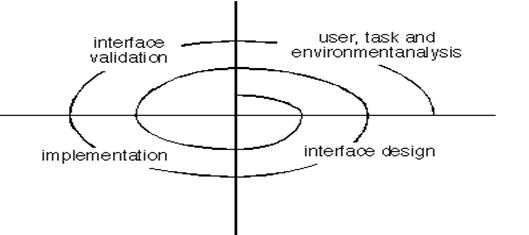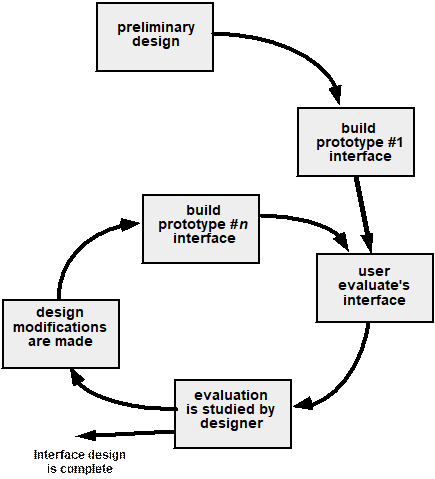Chapter 12
User Interface Design
CHAPTER OVERVIEW AND COMMENTS
Virtually all modern computer-based systems (and many legacy systems that are reengineered) have some type of interactive user interface, and most require reasonably sophisticated interface designs. It is easy for programmers to focus on splashy new technologies and ignore the fact that functionality and usability (not innovation) is what users are most concerned about.
This chapter outlines the design processes for software user interfaces.
Typical Design Errors
12.1 The Golden Rules
This section discusses three principles of user interface design. The first is to place the user in control (which means have the computer interface support the user’s understanding of a task and do not force the user to follow the computer's way of doing things). The second (reduce the user’s memory load) means place all necessary information on the screen at the same time. The third is consistency of form and behavior.
The three “golden rules” are:
These golden rules actually form the basis for a set of user interface design principles that guide this important software design action.
12.1.1 Place the User in Control
Mandel defines a number of design principles that allow the user to maintain control:
12.1.2 Reduce the User’s Memory Load
Whenever possible, the system should “remember” pertinent information and assist the user with an interaction scenario that assists recall.
12.1.3 Make the Interface Consistent
The interface should present and acquire information in a consistent manner:
A set of design principles that help make the interface consistent:
Allow the user to put the current task into a meaningful context. The user should be able to determine where he has come from and what alternatives exist for a transition to a new task.
Maintain consistency across a family of applications. “MS Office Suite”
If past interactive models have created user expectations, do not make changes unless there is a compelling reason to do so. Once a particular interactive sequence has become a de facto standard (Alt-S è save file), the user expects this in every application she encounters.
12.2 User Interface Analysis and Design
The overall process for analyzing and designing a UI begins with the creation of models of system.
12.2.1 User Interface Design Models
Four different models come into play when a user interface is to be analyzed and designed. “Prototyping”
Users can be categorized as:
12.2.1 The Process
The analysis and design process for UIs is iterative and can be represented using a spiral model.
The user interface analysis and design process encompasses four distinct framework activities:

The figure implies that each of these tasks will occur more than once, with each pass around the spiral representing additional elaboration of requirements and the resultant design. The construction involves prototyping which is the only practical way to validate what has been designed.
The analysis of the user environment focuses on the physical work environment. Among the questions to be asked:
The information gathered as part of the analysis activity is used to create an analysis model for the interface. Using this model as a basis, the design activity commences.
The construction activity normally begins with the creation of a prototype that enables usage scenarios to be evaluated.
12.3 Interface Analysis
A key tenet of all software engineering process models is this: you better understand the problem before you attempt to design a solution. Interface design analysis means understanding:
(1) The people (end-users) who will interact with the system through the interface;
(2) The tasks that end-users must perform to do their work,
(3) The content that is presented as part of the interface,
(4) The environment in which these tasks will be conducted.
12.3.1 User Analysis
The only way that a designer can get the mental image and the design model to converge is to work to understand the users themselves as well as how these people will use the system. This can be accomplished by:
User Interviews: The software team meets with the end-users to better understand their needs, motivations, work culture, and a myriad of other issues.
Sales Input: Sales people meet with customers and users to help developers categorize users and better understand their requirements.
Marketing Input: Market analysis can be invaluable in the definition of market segments while providing an understanding of how each segment might use the software in different ways.
Support Input: Support staff talks with users on a daily basis, making them the most likely source of information on what works and what doesn’t, and what they like and what they don’t.
The following set of questions help the interface designer better understand the users of a system:
The answers to these and similar questions will allow the designer to understand who the end-users are, what is likely to motivate and please them, how they can be grouped into different user classes or profiles, what their mental models of the system are and how the user interface must be characterized to meet their needs.
The goal of task analysis is to answer the following questions:
The techniques below are applied to the user interface:
Once interface analysis has been completed, all tasks required by the end-user have been identified in detail.
A number of UI design patterns are discussed in Section 12.4.2. Visit www.hcipatterns.org to explore the design patterns available for user interfaces.
12.4.2 Interface Design Patterns
Patterns are available for
12.4.3 Design Issues
12.5 Design Evaluation
Two interface design evaluation techniques are mentioned in this section, usability questionnaires and usability testing. The process of learning how to design good user interfaces often begins with learning to identify the weaknesses in existing products.

Once the first prototype is built, the designer can collect a variety of qualitative and quantitative data that will assess in evaluating the interface. Questions can be a simple Y/N response, numeric response, scaled response, Likert scale (strongly agree, etc.), percentage response, and open-ended ones.
Likert scale example:
http://www.gifted.uconn.edu/Siegle/research/Instrument%20Reliability%20and%20Validity/Likert.html
Source: https://www2.southeastern.edu/Academics/Faculty/galkadi/285/notes/Chapter12.doc
Web site to visit: https://www2.southeastern.edu/
Author of the text: indicated on the source document of the above text
If you are the author of the text above and you not agree to share your knowledge for teaching, research, scholarship (for fair use as indicated in the United States copyrigh low) please send us an e-mail and we will remove your text quickly. Fair use is a limitation and exception to the exclusive right granted by copyright law to the author of a creative work. In United States copyright law, fair use is a doctrine that permits limited use of copyrighted material without acquiring permission from the rights holders. Examples of fair use include commentary, search engines, criticism, news reporting, research, teaching, library archiving and scholarship. It provides for the legal, unlicensed citation or incorporation of copyrighted material in another author's work under a four-factor balancing test. (source: http://en.wikipedia.org/wiki/Fair_use)
The information of medicine and health contained in the site are of a general nature and purpose which is purely informative and for this reason may not replace in any case, the council of a doctor or a qualified entity legally to the profession.
The texts are the property of their respective authors and we thank them for giving us the opportunity to share for free to students, teachers and users of the Web their texts will used only for illustrative educational and scientific purposes only.
All the information in our site are given for nonprofit educational purposes